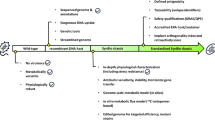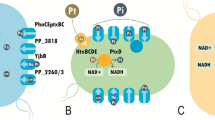Abstract
Pseudomonas oxalaticus OX1 carrying recombinant plasmid pFUS and 29 gramnegative bacteria were used as donor and recipients, respectively, for conjugations. The plasmid pFUS contains genes necessary for chemolithoautotrophic growth in a hydrogen-oxidizing bacterium,Alcaligenes hydrogenophilus. By the conjugal transfer of plasmid pFUS, 12 strains acquired the ability to grow in a mineral salts medium under a gas mixture containing H2, O2, and CO2.Pseudomonas cepacia carrying pFUS had hydrogenase and ribulose-1,5-bisphosphate carboxylase activities, and could grow at a rate almost equivalent to the growth rates of ordinary hydrogen-oxidizing bacteria.Pseudomonas acidophila carrying plasmid pFUS expressed indigenous antibiotic secretion under chemolithoautotrophic conditions. Plasmid pFUS could be stably maintained in these strains in the absence of selection pressure created by the addition of an antibiotic or chemolithoautotrophic conditions. This study shows that introduction of DNA fragments responsible for chemolithoautotrophic growth into a producer of valuable substances could be a promising technique for CO2 recycling.
Similar content being viewed by others
References
Kiyohara, M. (1993),Energy and Resorces 14, 91–97.
Ohi, K., Takada, N., Komemushi, S., Okazaki, M., and Miura, Y. (1979),J. Gen. Appl. Microbiol. 25, 53–58.
Friedrich, B., Friedrich, C. G., Meyer, M., and Schlegel, H. (1984),J. Bacteriol. 158, 331.
Umeda, F., Tanaka, N., Kimura, N., Nishie, H., Yagi, K., and Miura, Y. (1991),J. Ferment. Bioeng. 71, 379–383.
Umeda, F., Seko, T., Yano, K., Goda, N., Yagi, K., Miura, Y., and Mizoguchi, T. (1995),J. Ferment. Bioeng. 79, 59–61.
Haas, D. and Holloway, B. W. (1976),Mol. Gen. Genet. 144, 243–251.
Umeda, F., Urushihara, M., Tsujino, Y., Yagi, K., and Miura, Y. (1989),J. Ferment. Bioeng. 68, 207–209.
Yagi, K., Min, H., Urushihara, M., Manabe, Y., Umeda, F., and Miura, Y. (1986),Biochem. Biophys. Res. Commun. 137, 114–119.
Lowry, O. H., Rosebrough, N. J., Farr, A. L., and Randall, R. J. (1951),J. Biol. Chem. 193, 265–275.
Friedrich, C. G., Bowien, B., and Friedrich, B. (1979),J. Gen. Microbiol. 115, 185–192.
Hayase, N., Ishiyama, A., and Niwano, M. (1994),Appl. Environ. Microbiol. 60, 3336–3342.
Ishizaki, A. and Tanaka, K. (1991),J. Ferment. Bioeng. 71, 254–257.
Author information
Authors and Affiliations
Rights and permissions
About this article
Cite this article
Umeda, F., Yano, K., Gohda, N. et al. Acquisition of the ability to grow under autotrophic conditions by heterotrophic bacteria through the introduction of DNA fragments from hydrogen-oxidizing bacteria. Appl Biochem Biotechnol 57, 367–373 (1996). https://doi.org/10.1007/BF02941715
Issue Date:
DOI: https://doi.org/10.1007/BF02941715




